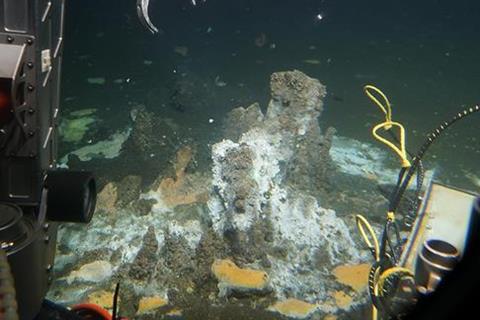Organic material deposited in the Guaymas Basin in the Gulf of California - a place characterised by hydrothermal seeps - is cooked by heat sources from within the Earth, which breaks it down into crude oil and natural gas.

Their components provide the primary source of energy for microorganisms in an otherwise hostile environment. In their latest study, the researchers have demonstrated that archaea use a previously unknown mechanism to degrade liquid petroleum alkanes at high temperatures without the presence of oxygen.
Alkanes are natural components of natural gas and crude oil. The latter is refined by humans into fuels like gasoline and kerosene.
In the presence of oxygen, microorganisms can rapidly break down many components of crude oil, among others alkanes. Without the reactive oxygen, however, degradation is considerably more difficult. Organisms that can perform this task have not been extensively researched.
Surprising mechanism
In recent years, however, evidence has been found that archaea are able to employ a surprising mechanism to do this, based on newly discovered variants of the key enzyme of methanogenesis and anaerobic methane degradation, methyl-coenzyme M reductase (MCR).
The genes that encode these enzymes have been found in many environmental samples. However, laboratory cultures of the microbes that could illustrate the function of these enzymes were still lacking.
Hanna Zehnle and her colleagues at MARUM (Center for Marine Environmental Sciences, University of Bremen) used sediments from the 2000-metre-deep Guaymas Basin in the Gulf of California. The special geological conditions that exist here include high temperatures, liquid crude-oil components, and an anaerobic environment at shallow sediment depths, all of which are normally only found in deep-lying oil reservoirs which are difficult for scientists to access.
Anaerobic cultures
In the Bremen laboratories the researchers prepared cultures with liquid alkanes and allowed them to grow anaerobically, i.e., without oxygen, at high temperatures (70 degrees Celsius).
“After a time, sulfide forms in the cultures. This provides evidence that they are active,” explains first author Hanna Zehnle. The composition of the cultures is studied using DNA and RNA samples.
“With this method we can find out what organisms are living in this system and which metabolic pathways they are using,” says Zehnle.
These include the chemical reactions in which substances are metabolized. They found archaea of the genus Candidatus Alkanophaga in the cultures. These archaea use variants of the MCR for breaking down the alkanes.
The researchers verified this by transcriptome data, measurement of the enzyme products, and by demonstrating inactivity of the cultures when the enzyme was inhibited. But the organisms are not able to degrade the crude oil alone. Respiration, in the form of sulfate reduction in this case (because no oxygen is present), is carried out by bacteria of the genus Thermodesulfobacterium, which form dense consortia with the archaea.
Carbon cycle
Methanogenesis is one of the oldest known metabolic processes and is a part of the global carbon cycle. The laboratory study by Hanna Zehnle and her colleagues shows that the enzymes involved in this process can also utilize liquid (and thus toxic) hydrocarbons which highlights the relevance of this pathway for the global carbon cycle.
“Thanks to their newly discovered capabilities, Alkanophaga and their relatives are targeting hydrocarbons in oil reservoirs. The remaining oil becomes more and more solid and therefore tends to remain in the seafloor,” explains corresponding author Gunter Wegener.
“We still have not been able to investigate any deep oil reservoirs, but the archaea are certainly annoying the oil industry with their activity. But they also make an important contribution to the fact that natural oil seeps are rare.”
This study is a part of the research within the Cluster of Excellence “The Ocean Floor – Earth’s Uncharted Interface”, which is housed at MARUM. Among other research areas, investigations are being conducted here to determine which microorganisms and environmental conditions provide the ocean floor with the qualities required to function as a reactor that has been balancing the Earth’s carbon cycle since time immemorial. Questions relating to what the organisms in the deep biosphere in higher temperature ranges live from is one of the core themes of the Cluster.







No comments yet